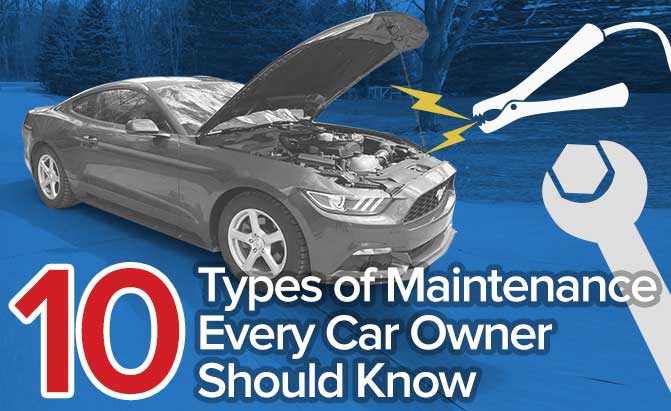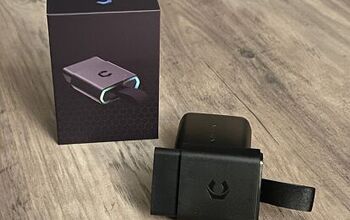Car Maintenance: 10 Things Every Car Owner Should Know - The Short List

Get the Flash Player to see this player.
How much do you know about the inner workings of your car or truck?
It’s OK if you’re not an automotive engineer. Of course, if you are, this probably isn’t for you because here are 10 basic things every motorist should be able to do. How many of them are you capable of?
10. Add Windshield Washer Fluid
Unobstructed visibility is critical to safe driving. Helping ensure your vehicle’s windshield is clear of precipitation and road grime is washer fluid. And fortunately, it couldn’t be simpler to keep the reservoir filled with plenty of this refreshing-looking-but-poisonous liquid. Just pop the hood and look for a cap with a windshield icon on it — they’re usually blue or yellow for easy spotting. Then, just pop it off and top ‘er up.
ALSO SEE: Top 10 Best Windshield Washer Fluids
9. Replace Windshield Wipers
But fluid is only half of the equation. Occasionally, you’ll need a fresh set of windshield wipers, point No. 9 on this list.
SEE ALSO: Top 10 Best Windshield Wipers
Luckily, it’s also an easy task to swap them as they essentially clip into place. To release a blade, there’s often a small button that you push, other times they slide into a hook on the end of the arm. In either case, the blades shouldn’t be overly difficult to swap out, so give it a try next time they’re smearing rather than wiping.
8. Check the Oil
Another mission-critical vehicle component is engine oil. And it’s super easy to check, provided you don’t own an electric car – they lack crankcases full of lubricant – or a modern BMW – which don’t have dipsticks.
Keeping an eye on the oil is a snap. Just make sure the vehicle’s sitting on a relatively level surface. And if you just parked it, wait a few minutes as the oil may not have completely drained back into the pan, which could result in a false reading. Then, pull the dipstick out, wipe it off with a rag or piece of paper towel and stick it back into the tube from whence it came. Then, pull ‘er out again and read the level. If the oil shows between the “Low” and “Full” marks you’re good to go.
Now, this is a case where more is not better. Having an overabundance of oil in an engine can be just as bad as not enough, it can lead to aeration and many other issues. Basically, just keep it between the marks and you’ll be fine.
7. Add Oil
But if the engine is low on lube, every driver should also be able to top off the crankcase. Just locate the filler cap, then pour a bit of oil down in there, and make sure it’s the correct viscosity! Wait a minute or so and check the dipstick again. To avoid overfilling, add small amounts until the correct level is achieved. Car engines typically take between four and five quarts, though this does vary. A Ram 3500 HD truck with the Cummins straight-six diesel requires three gallons of dinosaur juice. Make sure to check the owner’s manual for specific details.
But taking this a step further, you could also change the oil and filter, which usually isn’t that difficult. If you can do this, you’ve just earned major do-it-yourself bonus points.
ALSO SEE: Top 10 Best Synthetic Oil Products You Can Buy
6. Check the Tire Pressure
But next, let’s talk about the only part of your vehicle that should ever touch the road. Yes, that would be the tires. Point No. 6, all motorists should be able to check their car or truck’s tire pressure.
SEE ALSO: Top 10 Best Tire Pressure Gauges
Again, this is a very simple task. Just remove the valve-stem cap and stick a gauge firmly over the end. Make sure it seats well so no air leaks out around the edges, something that could lead to an inaccurate measurement. Now, unless there are special circumstances, it’s best to maintain the factory-recommend pressure, which is displayed on a placard, usually near the driver’s-side doorjamb. Inflate – or deflate – as required.
5. Change a Flat
And while we’re in this area, every driver should be able to change a flat tire, though, unfortunately, temporary spares have become less and less common, replaced by space-and-weight-saving emergency inflation kits. Still, the ability to jack a vehicle up, remove an offending flat and install a spare is an important skill to have, especially if you get a flat where cell-phone service is not available.
Also, add MAJOR bonus points if you’re able to rotate those tires, a process that’s a bit more time consuming, though the payoff is prolonged tire life. If your ride is newer, you’ll probably also have to reprogram the tire-pressure monitoring system so it accurately shows which tire is where.
ALSO SEE: Top 10 Best Floor Jacks for All Your Lifting Needs
4. Jump Start
Point No. 4 on this list of things every motorist should be able to do, is jump start a vehicle that has a dead battery. Of course, this requires a set of cables, a car or truck that’s fully charged (or a portable jump starter) and a little bit of know-how.
When attempting this, the most important thing is making sure you DO NOT mix up the leads. A positive terminal must connect to a positive terminal, negative to negative. If you switch them around VERY BAD THINGS can happen. A helpful hint to prevent this is that the color red is associated with positive and black with negative. Also, in modern vehicles, the negative cable doesn’t necessarily have to connect directly to the battery as the negative side is grounded to the engine and body structure, an engine bracket or metal part of the body will work just as well as a terminal. But, if in doubt, go for the battery.
ALSO SEE: Top 10 Best Portable Car Jump Starters
3. Replace the Air Filter
Fresh air is a wonderful thing. It’s as necessary to life as it is to your engine. Without a free-flowing supply of oxygen, internal combustion simply can’t take place. And that’s why it’s important to keep tabs on your vehicle’s air filter.
If it’s clogged with dirt and debris it won’t flow as much as it should, reducing your engine’s output. But the good news is they’re usually cheap and easy to replace.
SEE ALSO: Top 15 Best Engine Air Filters
Now, this will vary from one vehicle to another, but in many modern cars and trucks, the air filter is often found underneath a large rectangular housing, with the lid held in place by screws or clips. In either case, just pop it off to gain access to the filter itself. The new element should drop right in, but make sure to orient it the same way as the old one. The pleats need to face the incoming air to capture as much dirt as possible.
Many modern vehicles are also equipped with cabin filters, they clean the air before it enters the HVAC system. Depending on make and model, these can be easier or much harder to replace than an engine air filter. But give yourself EVEN MORE POINTS if you’re capable of performing this maintenance task.
2. Check the Belt
Point No. 2, every driver should be able to inspect their car or truck’s serpentine belt. Provided the part in question isn’t concealed by layer after layer of plastic shrouds it should be a snap to give a quick once-over. If the belt shows heavy abrasion, cracking across the grooves, lengthwise tearing or other obvious signs of damage you’ll want to replace it sooner than later.
And award yourself some SUPER BONUS points if you can tackle this job on your own. In theory, the process is simple, but it often feels like you need two extra sets of hands to get the belt positioned exactly where it needs to be. Remember, proper routing is critical for all vehicle accessories to function.
ALSO SEE: Top 10 Best Cars for Teens – The Short List
1. Inspect the Cooling System
Finally, every driver out there should be able to give their vehicle’s cooling system a good once-over. Critically important yet often ignored like that exercise equipment you bought around the holidays, in 2007, cooling systems have to cope with scorching summer heat and arctic cold. Keep an eye out for swelled, chafed, cracked or weeping hoses. They’re fixing to burst, which WILL leave you stranded. Also, make sure there’s enough coolant in the overflow reservoir. Add more as required. If the antifreeze looks discolored or rusty, the cooling system is LONG overdue to be flushed out. Something you can do yourself, if you fancy earning more bonus points.
Get the Flash Player to see this player.
Check out more episodes of The Short List

Born and raised in metro Detroit, Craig was steeped in mechanics from childhood. He feels as much at home with a wrench or welding gun in his hand as he does behind the wheel or in front of a camera. Putting his Bachelor's Degree in Journalism to good use, he's always pumping out videos, reviews, and features for AutoGuide.com. When the workday is over, he can be found out driving his fully restored 1936 Ford V8 sedan. Craig has covered the automotive industry full time for more than 10 years and is a member of the Automotive Press Association (APA) and Midwest Automotive Media Association (MAMA).
More by Craig Cole










































Comments
Join the conversation